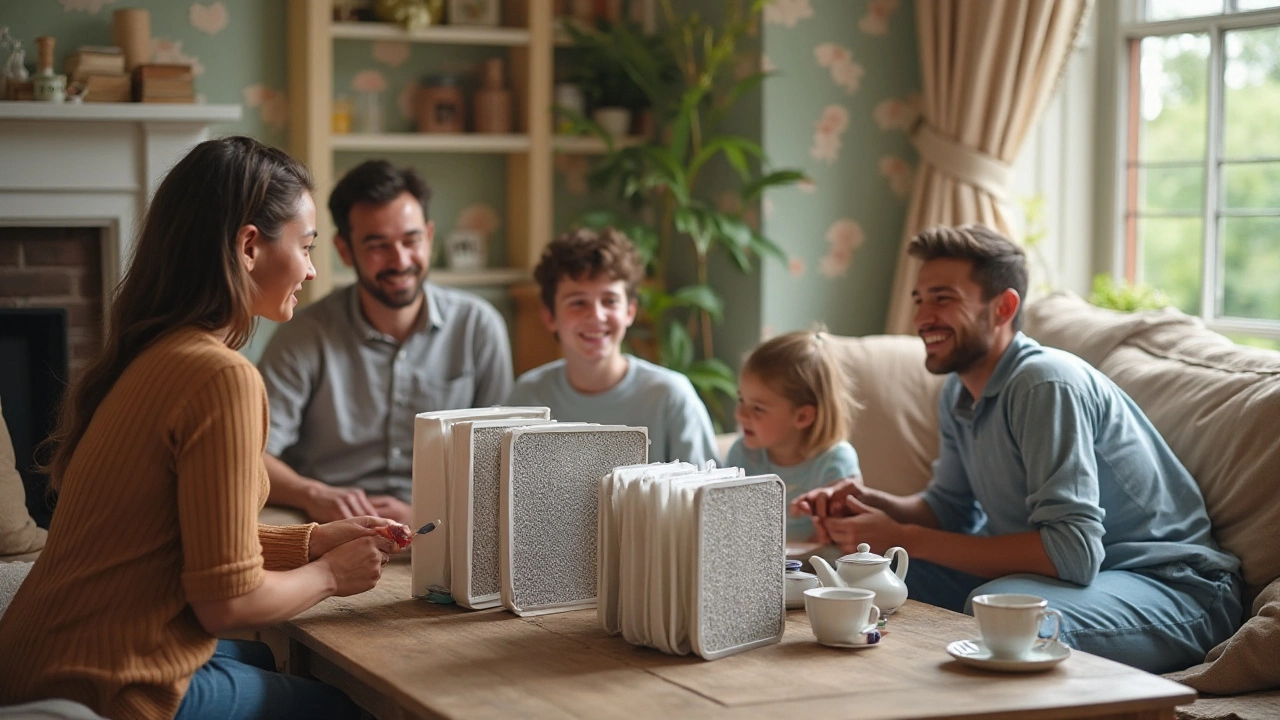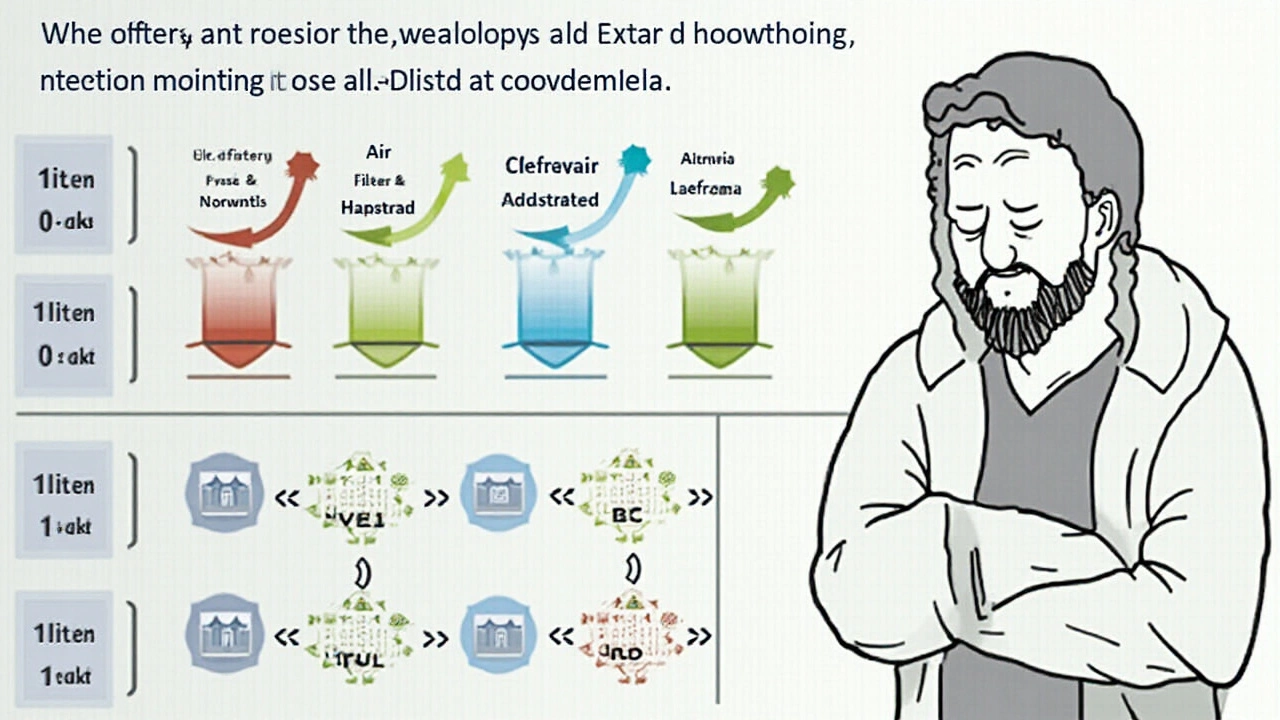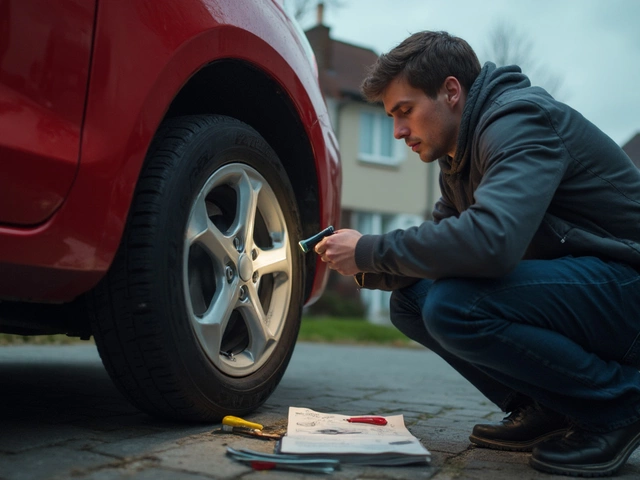In the modern pursuit of healthier living spaces, air filters play an invaluable role, but the market is flooded with options that vary widely in price. At first glance, the choice between a hundred-dollar filter and one costing half as much seems clear-cut: you get what you pay for, right?
Before reaching for your wallet, it's essential to understand the basics of how these filters work and what makes them tick. From the materials used to the technologies employed, each factor contributes to a filter's overall performance. This article aims to sift through the noise, shedding light on whether the hefty price tags are backed by tangible benefits or if they're merely the result of savvy marketing strategies.
Join us on this journey to unravel the truth behind pricey air filters, explore the science of clean air, and identify criteria that align with your individual needs and lifestyle.
- Understanding Air Filter Basics
- The Price vs. Performance Debate
- Filtration Technologies and Their Effectiveness
- Longevity and Maintenance of Air Filters
- Health Implications and Indoor Air Quality
- Making the Right Choice for Your Home
Understanding Air Filter Basics
Air filters are the unsung heroes of our homes, standing guard at the threshold between the outside world and the sanctity of our indoor environments. Their primary job is deceptively simple: they sift out particles, ensuring that the air we breathe indoors is much cleaner than outside. This process is not only about trapping dust and pollutants, but also about maintaining the delicate balance required for optimal indoor air quality. By improving the air inside, they help reduce allergies and prevent respiratory problems. However, not all air filters are created equal. Different types exist, and they vary dramatically in their design, materials, and intended use.
Understanding the difference starts with the materials. Fiberglass filters are the most basic, lightweight, and typically found in low-cost categories. They rely on a dense mat of spun glass fibers to catch particles. On the other hand, pleated filters, made from polyester or cotton, increase surface area and filtration efficiency. These are the preferred choice for many homeowners seeking better indoor air quality. For those striving for cleaner air, HEPA (High-Efficiency Particulate Air) filters are often the gold standard. Originally developed to capture radioactive particles during World War II, modern HEPA filters can remove up to 99.97% of particles as small as 0.3 microns, making them extremely effective.
Each type of filter brings its own set of advantages and trade-offs. While basic fiberglass filters might need frequent replacing, high-performance HEPA options can last longer but may require more expensive up-front investment. To decide which filter suits a home best, it's key to consider specific needs, such as household members' sensitivity to allergens or pet dander. As noted by the American Lung Association, "Improved indoor air quality not only helps with comfort, but is an important factor in reducing health-related issues associated with poor air quality."
The Environmental Protection Agency highlights that filters with a Minimum Efficiency Reporting Value (MERV) rating between 7 and 13 are suitable for most residential HVAC systems, offering a good balance of performance without overburdening the system.
Beyond the materials and effectiveness, it's essential to consider the air filter's lifecycle and how often they should be replaced. Proper maintenance ensures optimum performance. A clogged or old filter can hamper airflow, reducing its ability to do its job. This can lead to increased energy costs and strain on HVAC systems. The settings and environments also influence lifespan—a home in a dusty area or with pets might need filter changes more frequently. In terms of maintenance and economics, one must weigh the options between opting for cheaper filters with frequent replacements or investing in higher-end choices that might last longer. By understanding these fundamental differences, homeowners can make more informed decisions about what type of air filters will provide the best benefits for their needs.
The Price vs. Performance Debate
In the labyrinthine world of air filters, the age-old quandary – does spending more equate to receiving better performance? – persists as one of the ubiquitous dilemmas faced by consumers. On one side, marketers extolling the virtues of costly air filters promise seamless efficiency and robust health benefits, while on the other, budget-friendly alternatives boast similar claims with a fraction of the cost. It's a tug-of-war that demands a discerning eye and a thoughtful approach. Many late-night infomercials and glossy ads might leave you convinced that a heftier price tag ensures pristine indoor air quality and miraculous health transformations. Yet, reality begs for a deeper dive into the mechanics behind those promises. Are high-priced air filters embedded with exclusive technology, or are consumers merely reeling from a masterclass in branding?
The conversation doesn't end with price tags and enticing packaging. Performance in air filters is intrinsically tied to the materials used and the intricacies of design, of which pleated filters and HEPA models often headline the discussion. HEPA filters, for instance, pride themselves on capturing minuscule particles with unparalleled precision. Some studies even claim that HEPA filters can trap up to 99.97% of particles as small as 0.3 microns. But here's the kicker: not every expensive filter is a HEPA filter, and not every HEPA filter is expensive. This invites the question—what are consumers really paying for?
"Price is what you pay, value is what you get," remarked famed investor Warren Buffet. This sentiment rings especially true in the realm of indoor air quality solutions, where perceived value needs to align with actual performance and health benefits. To make sense of cost discrepancies, one must consider the nuanced landscape of air filters, represented by different grades like MERV (Minimum Efficiency Reporting Value). Higher MERV ratings, typically promise superior filtration and are often synonymous with premium pricing. Yet, a filter's ability to transform air quality is influenced by factors beyond ratings and price—a thought process worth mulling over in the pursuit of informed purchases.
Consider also the notion of longevity. A filter's performance isn't solely reliant on its initial effectiveness. The true test of its value emerges over time. As dust, pollen, and pet dander gradually accumulate, even the most high-end filter can falter without proper upkeep and regular replacement. Hence, hidden costs associated with maintenance and replacement complicate the price-performance ratio, requiring seasoned judgment. Diving into customer reviews infuses another layer into the narrative. Here, anecdotal evidence runs rampant, from exaltations of discernible purity in air quality, to expressions of frustration over exaggerated promises. In this cacophony of experiences lies truth, urging potential buyers to balance qualitative insights with quantitative data.
To unravel the price-performance conundrum with accuracy, a prospective buyer must first align the choice of air filters with specific lifestyle needs and environmental conditions. Those plagued with allergies or asthma may find solace in investing in premium variants, while others might suffice with moderate options that fit snugly into their budget. In weighing the scales of cost versus performance, let skepticism serve as a guide, allowing a harmonious blend of critical analysis and trust to pave the way forward.

Filtration Technologies and Their Effectiveness
The realm of air filtration technologies is vast and varied, leaving many of us wondering about the most effective way to cleanse the air within our homes. At the heart of this inquiry is whether expensive air filters provide a tangible improvement in indoor air quality compared to their more affordable counterparts. Several types of filtration technologies populate the market, each boasting unique benefits and mechanisms. Understanding these technologies is key to making an informed purchasing decision.
One of the most commonly discussed technologies is the High Efficiency Particulate Air (HEPA) filter, synonymous with top-notch performance and reliability. HEPA filters intricately weave a web that traps minuscule particles, down to around 0.3 microns in size. This characteristic makes it a popular choice for those with allergies or asthma. While some cheaper models claim to incorporate HEPA-like qualities, it's important to verify their standards to ensure you're getting proven results.
Electrostatic filters, on the other hand, use an entirely different principle, leveraging static electricity to attract particles. Their effectiveness often ties back to the strength of the electrostatic charge, which can vary widely across products. Notably, electrostatic filters can span a broad price range, with premium options boasting stronger charges and improved particle retention. However, those considering these filters must weigh potential ozone emissions, a byproduct of certain models, which can be a concern for sensitive individuals.
Activated carbon filters represent another technology, effective specifically in removing odors and gaseous pollutants rather than particulate matter. They excel at absorbing volatile organic compounds (VOCs) often emitted by household products and furnishings. To maximize their strength, they are frequently used in combination with HEPA filters, offering a broader spectrum of cleaning capabilities. When choosing a filter, it's helpful to consider whether your primary concern is smoke, odors, or purely particles, as this will inform the best type for you.
An article by Consumer Reports indicates, 'The allure of premium filters often lies in their multifunctional capacities; nonetheless, a thorough understanding of your specific air quality needs can prevent overspending.' This rings true in the air filtration domain, where understanding leads to optimized solutions.
For those budget-conscious buyers, washable filters may present an attractive opportunity. Though not famed for their precision in capturing the smallest irritants, their reusable nature can offer continuous savings, crucial for anyone looking to balance financial constraints with air quality concerns. Be mindful, however, that neglecting maintenance can diminish their effectiveness over time.
Beyond Technology: Considerations for Effectiveness
While the technology behind a filter is crucial, its effectiveness is also reliant on several key factors, such as installation, maintenance, and the environment's specific needs. Many filters lose efficacy when not properly fitted, allowing unfiltered air to bypass the intended cleaning path. Regular maintenance, from cleaning to timely replacements, ensures your filter remains operational at its full capacity. In regions with mild air pollution, a less advanced filter may suffice, yet in more urban settings, a higher-tech solution could be warranted.
Regardless of the path chosen, understanding the mechanics and science behind filter performance equips consumers with the tools needed to shop intelligently. This knowledge lays the foundation for personalized decisions, ensuring your investment aligns not just with your budget, but also with you and your family's health priorities.
Longevity and Maintenance of Air Filters
Air filters are not just a purchase; they're an investment in your indoor air quality. The lifespan and upkeep of an air filter are crucial factors that can tip the balance between a wise purchase and unnecessary expenditure. Understanding the longevity of your air filter can save you both time and money. On average, filters need to be replaced every three months. However, this varies widely depending on several factors like the type of filter, the environmental conditions, and the specific needs of a household. If you're using a filter with a higher MERV rating, you might find that it clogs more quickly due to capturing finer particles, which could necessitate more regular changes.
Maintaining air filters isn’t as simple as popping a new one in every quarter. Your environment significantly impacts filter lifespan; pet owners, for example, will find that fur and dander can contribute to more frequent replacements. Urban homes dealing with soot or rural homes amidst pollen-heavy environments might also see a quicker decline in filter efficacy. If someone in your household suffers from allergies, the situation demands even more frequent checks and replacements to ensure the indoor air remains as clean as possible.
There's a popular misconception that pricier air filters, due to their advanced technology, last longer and require less maintenance. This isn’t necessarily true. While top-of-the-line filters might be more efficient at improving indoor air quality, they don't always stand the test of time better than less expensive counterparts. Always keep a close eye on filters, checking them monthly for visible dirt and decrease in airflow. A simple checklist could be: Is the air in your home feeling fresh? Are your energy bills creeping up because your HVAC system is working overtime? These could be signs that a replacement is due.
According to research from the Environmental Protection Agency, 'an efficient maintenance routine can improve HVAC efficiency by 5% to 15%.'
Regular maintenance practices can significantly increase the lifespan of air filters. Cleaning the external grille of the filter can also help. In reusable filter models, ensure that these are washed and dried thoroughly before being reinstalled. Ignoring moisture can lead to mold growth, introducing a new health hazard while trying to eliminate air impurities. Another tip is to run your HVAC system fan periodically even when heating or cooling isn't needed. This practice allows your air filter to continue capturing unwanted particles and keeps the air cleaner.
For those who have just installed a high-cost air filter, monitoring both the filter and air quality improvements can hold essential insights. A straightforward habit is to note down the installation date on the filter itself, which acts as a gentle reminder for the inevitable replacement. Remember, no matter the technology or price, air filters are not a set-and-forget component. Their effective performance relies significantly on regular checks, timely replacements, and mindful maintenance practices, ensuring that the money you invest truly serves its purpose by keeping your home’s air pristine.

Health Implications and Indoor Air Quality
The quality of the air we breathe indoors has profound effects on our health, something that becomes more pressing as people spend an increasing amount of time inside. Indoor air quality isn't just about comfort; it's a crucial element of health. Poor air quality can exacerbate allergies, lead to respiratory problems, and in severe cases, contribute to chronic illnesses. Air filters are a frontline defense in maintaining healthy air, but the question remains—does a higher price tag equate to better health protection? Understanding how different air filters impact indoor air starts with their capability to capture pollutants like dust, pollen, and even microorganisms. While basic filters can trap large particles, pricier options often employ advanced technologies like activated carbon or HEPA filtration to target finer particulates and volatile organic compounds (VOCs).
HEPA filters, for example, are renowned for their effectiveness in removing over 99.97% of particles as small as 0.3 microns. This is particularly beneficial for individuals with asthma or other respiratory conditions. Such filters can significantly reduce the presence of allergens that trigger reactions. Dr. Lisa Smith, an environmental health expert, notes,
While upgrading to a high-cost filter can be beneficial, it's crucial for consumers to assess the specific needs of their environment. Prioritizing filter efficiency for pollutants relevant to one's living area is key.However, it’s important not to overlook maintenance in this equation. Expensive filters might offer superior filtration, but if they are not consistently changed or cleaned, their efficacy is compromised. Consistent maintenance ensures that any filter, irrespective of cost, performs optimally.
Analyzing data from service reports, homes using high-grade expensive air filters show a marked decrease in airborne contaminants compared to those with standard filters. Yet, the health improvements associated with these filters can be tied to the type of pollutants prevalent in the home's location. For instance, urban areas might benefit more from filters that target fumes and chemicals, whereas rural homes may focus on pollen and dust. The important takeaway is matching the filter type to environmental specifics for health gains. An informed choice based on personal needs, budget, and local air quality conditions will ensure that the right balance of price and performance is achieved, leading to healthier indoor environments across various settings.
Making the Right Choice for Your Home
When deciding on the best air filter for your home, it's crucial to consider several factors that go beyond price tags. First, assess the specific needs of your household. Are there any members with allergies or respiratory issues? Homes with sensitive occupants might benefit substantially from high-efficiency filters, like HEPA. These filters are renowned for their ability to capture tiny particles and are often valued for creating healthier indoor environments. Families without health concerns might find that less expensive filters suffice in maintaining adequate indoor air quality.
Also, take stock of the various filtration technologies and how they align with your household's priorities. Mechanical filters like those made from fiberglass can trap large particles but may fall short of capturing smaller pollutants. On the other hand, activated carbon filters excel in removing odors and volatile organic compounds (VOCs), making them ideal for households with pets. Weighing these attributes against your lifestyle needs will help make an informed choice.
Compatibility and Maintenance
Compatibility is another crucial aspect. Not all air filters fit every HVAC system, so double-check your system's specifications. Improper fit can lead to air leakage and reduce the filter's efficiency. Maintenance is also vital for optimal performance. Consistent filter replacements, as recommended by the manufacturer, can prevent circulation of contaminants and enhance the longevity of your HVAC system. For those daunted by upkeep, washable filters present as a convenient option, combining performance with ease.
One way to decide if high-cost filters are necessary is to look at independent test results. Consumer-oriented entities like Consumer Reports provide performance tests of air filters and can help guide your decision.
"Choosing an air filter is not just about the upfront cost," said William Lange, a senior home editor for a popular lifestyle magazine. "It's an investment in your family's health and comfort."
Lastly, consider the frequency and type of filter replacements. Some filters are designed to last 90 days, while others can stretch to a year. Your HVAC usage, the presence of pets, and local air quality can all influence the necessary frequency of changes. Keeping this in mind will ensure you get the most out of your purchase both in air quality and in energy efficiency, safeguarding against clogged filters that overburden your home's ventilation system. Granular details about what each type of air filter offers are invaluable during your decision-making process. Don't skip this crucial research step when comparing filter performance.






